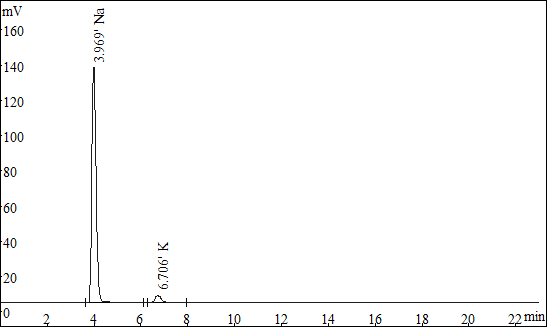In recent years, with the continuous optimization of preprocessing methods, the development of new multifunctional chromatographic columns, the increasing maturity of detergent generator technology, the exploration of multiple detector combination technologies, the ion chromatography (IC) has become increasingly widely used in the pharmaceutical industry. Ion chromatography (IC) is suitable for detecting compounds soluble in water and with certain ionsociation, particularly unvolatile and without UV absorption, to supplement the deficiency of liquid-phase and gas-relative ionic drug analysis. Ion chromatography (IC) can be used to analyze various components of anions, cations, organic acids, organic amines, sugars, and antibiotics, and can provide a scientific guarantee for the quality and safety of drugs. To this end, SHINE researchers have carried out a series of experimental determination around "the application of ion chromatography in the pharmaceutical industry", I hope that the pharmaceutical industry or outside the industry staff to have more reference and understanding of the application of ion chromatography.

Raw material medicine refers to the raw material used for the production of various preparations, which is an effective ingredient in the preparation, and the various powder, crystallization, ointment prepared by chemical synthesis, plant extraction or biotechnology. Only when raw materials are processed into pharmaceutical preparations can they become a drug for clinical use, so the quality of raw drugs determines the quality of the preparations. Countries in the world have formulated strict national Pharmacopoeia standards and quality control methods for their widely used API and its related preparations, so as to strengthen the control of toxic ingredients in drugs, strengthen the qualitative and quantitative research of drug impurities, and further improve the quality control requirements related to drugs and effectiveness.
1. Determination of potassium in potassium parpapartate
Potassium minpartate, an electrolyte supplement, is used for the treatment of hypokalemia, periodic quadriplegia caused by hypokalemia, arrhythmia caused by didihuang poisoning, etc. Need to monitor the potassium content during the potassium minpartate production process to guide the production, the product also needs to detect the potassium content to control the quality.
Analysis column: SH-G-1 + SH-CC-3L
Flow phase: 5.5 mM MSA (EG)
Flow speed: 1.0 mL/min
Column temperature: 35℃
Suppressor: SHY-C-5
Injection volume: 25 μL

Figure 1 Spectrum of potassium in potassium parpapartate
2. Determination of iodine in diosmin
Diosmin is a drug that enhances venous tension, reduces vascular embrittleness and abnormal permeability, promotes lymphatic reflux, and improves microcirculation. Clinically, it is mainly used to treat the treatment of chronic venous and lymphatic insufficiency related symptoms caused by various reasons, including varicose veins, venous edema, thrombotic phlebitis, deep venous thrombosis, and can also be used for the treatment of acute, chronic hemorrhoids and other related symptoms. For the venous system, the product enhances the venous tension by extending the contraction time of adrenaline on the venous wall; for the microcirculation system, the product can reduce the capillary permeability and enhance its resistance; for the lymphatic system, the product increases the lymphatic drainage speed and lymphatic contraction action, improve the lymphatic reflux and reduce the symptoms of edema. Common synthesis method of diosamine: dissolve orange picine in pyridine, iodine iodine, make crude products by dehydrogenation, and make finished drugs purified by pure water. Therefore, the iodine residue should be detected in the finished medicine to regulate the control of drug articles. The sample was processed pre-combustion, alkaloid absorbed, iodine ions separated by ion chromatography and detected by ampere detector.
Analysis column: SH-G-1 + SH-AC-17
Flow phase: 10.0 mM KOHl
Flow speed: 1.0 mL/minl
Column temperature: 35℃
Test method: DC amp testing
Injection volume: 25 μL
Prior treatment: the sample is pre-combustion, absorbing liquid (add S2O32-) 0.22 μm

Figure 1 Iodde spectrum in Diosiine
3.Determination of cation and anion in polyethylene glycol 4000 powder.
A mixture of polyethylene glycol 4000 dispersed, ethylene oxide and water condensation with sorbitol for the treatment of constipation in adults and children 8 years and older (including 8 years old). Polyglycol (4000) is a linear long chain polymer that holds water molecules by hydrogen bonds, keeps water within the colon, increases the fecal moisture content and sofstool, restores stool volume and weight to normal, promotes the completion of defecation, thus improving symptoms of constipation. Sulphate ions, chloride ions, which are not easily absorbed, the infiltration of unabsorbed anions and other related cations makes water retained in the gastrointestinal tract, when large amounts of water can lead to water-like diarrhea. The content of chlorine, sulfate, sodium and potassium ions in polyethylene glycol 4000 dispersion should be determined according to the relevant quality standards
(1) Polyethylene glycol 4000 scattered medium anion
Analysis column: SH-G-1 + SH-AC-4
Flow phase: 2.0 mM Na2CO3+8.0 mM NaHCO3
Flow speed: 1.5 mL/minl
Column temperature: 35℃.
Suppressor: SHY-A-6l.
Injection volume: 25 μL
Pretreatment: Take approximately 1 g sample (accurately recorded quality to 0.0001 g) and dissolve with ultra-pure water to 100 mL,. 00 Film sample analysis over 0.22 μm after moderate dilution

Figure 1 Spectrum of anions in polyethylene glycol 4000 powder
(2) Cation in polyethylene glycol 4000 powder
Analysis column: SH-G-1 + SH-CC-4
Flow phase: 5.0 mM methane sulfonic acid
Flow speed: 1.0 mL/min
Column temperature: 35℃
Suppressor: SHY-C-5.
Injection volume: 25 μL.

Figure 2 Spectrum of cations in polyethylene glycol 4000 powder